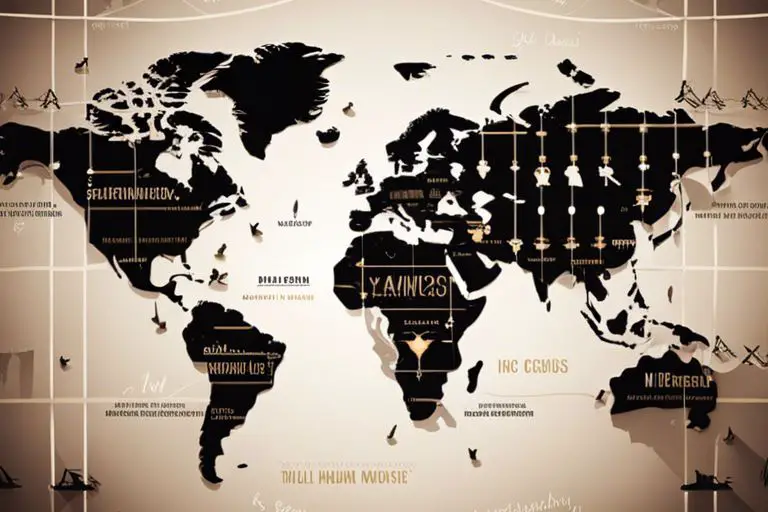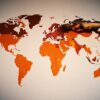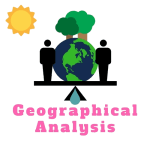Peripatetic movements have been an inherent aspect of human history, shaping societies, cultures, and landscapes. Understanding the patterns and factors that drive human migration is crucial in comprehending the intricate tapestry of our past. This informative blog post delves into the geography of human migration, from ancient nomadic tribes to modern-day global mobility. We will explore the impact of migration on various regions, the challenges and opportunities it presents, and the enduring legacy of these migratory footprints on the world’s map. Join us in uncovering the fascinating story of human movement and its profound influence on our history and present-day reality.
Key Takeaways:
- Migration as a driving force: The history of human migration has played a pivotal role in shaping societies, cultures, and economies. It has facilitated the exchange of ideas, goods, and technologies, leading to cultural diversity and innovation.
- Impact of geographical factors: Geographical factors such as natural barriers, climate, and resources have significantly influenced the patterns and routes of human migration. These factors have affected the distribution of populations and the development of civilizations.
- Integration of migration and history: Understanding the geography of human migration provides valuable insights into the historical movements of populations and the interconnectedness of different regions. It helps us comprehend the complexities of human history and the evolution of societies over time.

Historical Migrations: A Global Tapestry
Any study of human migration reveals a rich and intricate tapestry of movement and settlement. Throughout history, humans have traversed the globe in search of new opportunities, resources, and refuge. The resulting patterns of migration have shaped the course of history, influencing the development of civilizations and the spread of cultures.
Early Human Dispersal Out of Africa
Dispersal out of Africa started over 100,000 years ago, as early humans began to migrate to other parts of the world. These early migrations were driven by a combination of changing environmental conditions and the quest for new areas to inhabit. As human populations spread across the continents, they adapted to diverse landscapes and climates, contributing to the rich diversity of human cultures and societies today.
Massive Movements: The Indo-European and Bantu Migrations
Migrations of the Indo-European and Bantu peoples were some of the most significant movements in human history. The Indo-European migration, which began around 4,000 years ago, led to the expansion of languages and cultures across Europe and parts of Asia. The Bantu migrations, which started around 3,000 years ago, played a crucial role in shaping the demographics and cultures of sub-Saharan Africa. These massive movements of people had a lasting impact on the societies they encountered, influencing language, religion, and social structures.
Early human migrations shaped the course of human history, laying the groundwork for the diverse societies and cultures present in the world today. They were driven by a combination of changing environmental conditions, the quest for new areas to inhabit, and the search for resources and opportunities. The resulting patterns of migration have had a lasting impact on the development of civilizations and the spread of cultures.
Migration Factors and Drivers
Now, when we discuss the factors and drivers behind human migration, several key influences come into play. These include environmental change, agricultural advancements, political turmoil, and socioeconomic factors. Understanding these driving forces is crucial in tracing the footprints of history and comprehending the patterns of human migration throughout time.
Environmental Change and Agricultural Advancements
On the one hand, environmental changes such as climate shifts, natural disasters, and resource depletion have historically influenced human migration patterns. The need to seek habitable environments or fertile lands has driven populations to move in search of sustenance and safety. Additionally, agricultural advancements have also played a significant role, as the discovery of new farming techniques and crops has led to population shifts in pursuit of better agricultural opportunities.
Political Turmoil and Socioeconomic Factors
The other major driving forces behind human migration are rooted in political turmoil and socioeconomic factors.
- War,
- conflict,
- oppression,
- persecution, and
discrimination have historically forced millions to flee their homes in search of safety and freedom.
-
- Meanwhile,
-
- economic instability,
- poverty, and
- limited opportunities have driven populations to seek better livelihoods in new regions.
-
These factors have contributed to significant migratory movements throughout history, shaping the cultural and demographic landscape of our world.
Drivers such as conflict, discrimination, and economic instability have had a profound impact on human migration, often leading to perilous journeys and uncertain futures for those affected.
Modern Migration: Trends and Challenges
For centuries, humans have been on the move, seeking new opportunities, safety, and better lives. In the modern era, migration has taken on new dimensions, driven by economic, political, and environmental factors. This chapter delves into the trends and challenges of modern migration, highlighting the complexities and consequences of this global phenomenon.
The Age of Mass Migration and its Effects on Nations
Effects of mass migration during the late 19th and early 20th centuries had profound impacts on nations around the world. The influx of migrants to industrialized countries led to rapid urbanization, cultural shifts, and labor market changes. In the United States, for example, the arrival of millions of European immigrants reshaped the demographic and social fabric of the nation, contributing to its growth and prosperity. However, the challenges of integration and assimilation also posed significant difficulties for both newcomers and native-born citizens.
Contemporary Migration Issues: Refugees and Asylum Seekers
Mass displacement of people due to conflicts, persecution, and natural disasters has given rise to contemporary migration issues, particularly the plight of refugees and asylum seekers. The global refugee crisis has strained resources and tested the capacity of nations to provide protection and support for those fleeing violence and persecution. Additionally, the influx of asylum seekers has sparked political debates and fueled anti-immigrant sentiments in some countries, creating complex social and humanitarian challenges.
Refugees and asylum seekers face daunting obstacles as they seek safety and stability in unfamiliar lands. The process of seeking asylum is often fraught with uncertainty, bureaucratic hurdles, and the risk of deportation. For these vulnerable populations, access to basic rights and services, such as healthcare, education, and employment, is often limited, placing them at greater risk of exploitation and marginalization.
Mapping Migration: Tools and Methodologies
Despite the complexities and challenges associated with mapping human migration, there are several tools and methodologies that have been developed to study and track this phenomenon. From traditional cartography to the use of technology and big data analysis, these tools have greatly enhanced our understanding of migration patterns and trends throughout history.
Traditional Cartography and Migration Studies
For centuries, maps have played a crucial role in understanding human migration. Traditional cartography, which involves the creation and study of maps, has been a fundamental tool in migration studies. Cartographers have used various techniques such as historical maps, atlases, and geographic information systems (GIS) to visualize and analyze migration routes, patterns, and the impact of migratory movements on different regions. These maps have helped researchers and scholars to trace the historical footprints of human migration and examine the spatial distribution of different ethnic groups and cultures.
With the advancements in technology and the availability of big data, modern mapping techniques have revolutionized the study of human migration. Geographic information systems (GIS), remote sensing, and satellite imagery have become invaluable tools for tracking migration patterns and trends. These technologies enable researchers to analyze large datasets and visualize complex migration routes in unprecedented detail. The integration of big data analysis has empowered scholars to identify and predict migration patterns, understand the drivers of migration, and assess the impact of migration on the environment and society.
Role of Technology and Big Data Analysis in Modern Mapping: The role of technology and big data analysis in modern mapping cannot be overstated. These tools have revolutionized the study of human migration by enabling researchers to analyze large datasets and visualize complex migration routes in unprecedented detail. By harnessing the power of technology and big data analysis, scholars have been able to identify and predict migration patterns, understand the drivers of migration, and assess the impact of migration on the environment and society, ultimately contributing to a deeper understanding of the complex interplay between human populations and their geographical environments.
Case Studies in Human Migration
Not only does studying the history of human migration provide insight into our past, but it also sheds light on the interconnectedness of different cultures and societies. Here are some case studies that demonstrate the complexity and impact of human migration:
-
-
- Traces of a Distant Past – A study of prehistoric human migration patterns based on the examination of ancient DNA samples. Traces of a Distant Past is a fascinating look at how human migration has shaped the genetic diversity of modern populations.
- The Great Atlantic Migration to the New World – An exploration of the mass migration of Europeans to the Americas in the 19th and early 20th centuries, including the push and pull factors that drove this movement.
- The 20th Century’s Migration Crises: Lessons from History – A look at the upheaval caused by conflicts and political turmoil in the 20th century, resulting in massive refugee movements and the lasting impact on global demographics.
-
The Great Atlantic Migration to the New World
Atlantic migration to the New World in the 19th and early 20th centuries reshaped the demographics and cultural landscape of the Americas. Millions of Europeans, primarily from Ireland, Italy, and Eastern Europe, sought opportunity and a fresh start in the Americas. The mass movement was driven by economic struggles, political unrest, and the promise of a better life in the New World. This migration wave resulted in the establishment of vibrant immigrant communities that continue to influence the cultural tapestry of the Americas today.
The 20th Century’s Migration Crises: Lessons from History
An examination of the tumultuous 20th century reveals a series of migration crises driven by wars, political upheaval, and persecution. The two World Wars, the breakup of empires, and the rise of totalitarian regimes forced millions of people to flee their homes in search of safety and stability. These mass movements of people had far-reaching consequences, significantly altering the demographic makeup of regions and reshaping geopolitical dynamics. With the onset of the Cold War, the world witnessed a new wave of migration as people sought refuge from communist regimes in Eastern Europe and Asia.
With each case study, it becomes evident that human migration is a complex and impactful force that has shaped the course of history. It demonstrates the resilience of individuals and communities in the face of adversity, while also highlighting the challenges and opportunities that arise from the movement of people across borders.
Migration and Cultural Exchange
After exploring the historical patterns of human migration, it becomes evident that migration has been closely linked to cultural exchange. As people move from one place to another, they bring with them their customs, traditions, and way of life, which inevitably leads to a blending and exchange of cultures.
The Impact of Migration on Language and Religion
With the movement of people across geographic regions, the influence on language and religion becomes profound. New languages and dialects develop as different cultures interact and assimilate, leading to a rich tapestry of linguistic diversity. Similarly, the spread of religious beliefs and practices occurs through migration, shaping the spiritual landscape of new communities and societies.
Cuisine and Cultural Artifacts: The Subtle Influences of Migration
For millennia, migration has played a significant role in the transmission of culinary traditions and the exchange of cultural artifacts. As people migrate, they bring with them their traditional recipes and cooking methods, leading to the fusion of flavors and culinary techniques. Additionally, cultural artifacts such as art, music, and literature are shared and adapted, enriching the cultural heritage of different regions.
Cultural exchange through migration has contributed to the diversification of global cuisine and the preservation of traditional crafts and artistic expressions. Through the migration of people and the exchange of cultures, the world has been introduced to a myriad of flavors, art forms, and cultural practices, creating a more interconnected and vibrant global community.
Future of Human Migration
Keep pace with the ever-changing landscape of human migration is crucial to understanding the future of the global population. As the world continues to evolve, so do the patterns of human movement across borders. Examining the potential factors that will drive future migrations will help us prepare for the challenges and opportunities ahead.
Predicting Patterns: Climate Change and Potential Hotspots
Hotspots of future migration are likely to be heavily influenced by the effects of climate change. Displacement due to rising sea levels, extreme weather events, and resource scarcity will contribute to the movement of people from vulnerable areas to more stable regions. Predicting these patterns will help policymakers and communities prepare for the influx of migrants and the strains it may place on infrastructure, resources, and social systems.
Hotspots of future migration are likely to be heavily influenced by the effects of climate change. Displacement due to rising sea levels, extreme weather events, and resource scarcity will contribute to the movement of people from vulnerable areas to more stable regions. Predicting these patterns will help policymakers and communities prepare for the influx of migrants and the strains it may place on infrastructure, resources, and social systems.
Migration Policy: Global Governance and Human Rights
For effective management of future migration, a coordinated, global approach to governance and human rights is essential. As migration patterns continue to shift, it is imperative that policies and regulations are adapted to ensure the protection and dignity of migrants. Additionally, recognizing the rights of displaced populations and working towards sustainable and equitable solutions will be critical in shaping the future of human migration.
Future migration policy and global governance will need to address the complexities of climate-induced displacement and the protection of human rights. With the potential for mass migration due to environmental and geopolitical factors, proactive measures must be taken to mitigate the risks and ensure the safety and well-being of all individuals. The future of human migration will be shaped by our ability to uphold humanitarian values, navigate geopolitical challenges, and adapt to the changing climate.
Conclusion: The Geography Of Human Migration – Tracing The Footprints Of History
So, as we have explored the intricate patterns of human migration through the ages, it is evident that the movement of people has shaped the course of history in profound ways. From the earliest nomadic tribes to modern-day immigrants, the interplay between geography and human migration has left an indelible mark on the world. By tracing these footprints of history, we gain a deeper understanding of the forces that have driven people to seek new lands, opportunities, and experiences. As we continue to study and analyze these movements, we are better equipped to comprehend the complexities of human societies and the ever-changing dynamics of our global landscape.
FAQ
Q: What is the significance of studying the geography of human migration?
A: The geography of human migration is significant as it provides insights into the historical movements of people, the impact of migration on the environment, and the spread of cultures and societies. Understanding human migration is crucial for understanding the development of societies and the interconnectedness of different regions throughout history.
Q: How does human migration shape the modern world?
A: Human migration has played a crucial role in shaping the modern world by influencing the demographics, cultures, and economies of different regions. It has contributed to the diversity of societies and has led to the exchange of ideas, technologies, and resources, ultimately impacting global politics and economics.
Q: What are some examples of significant human migration events in history?
A: Significant human migration events in history include the ancient Silk Road trade routes, the European colonization of the Americas, the Transatlantic Slave Trade, the post-World War II migration of refugees, and the contemporary global movement of labor migrants. These events have had profound and lasting effects on the geography, cultures, and societies of the world.







